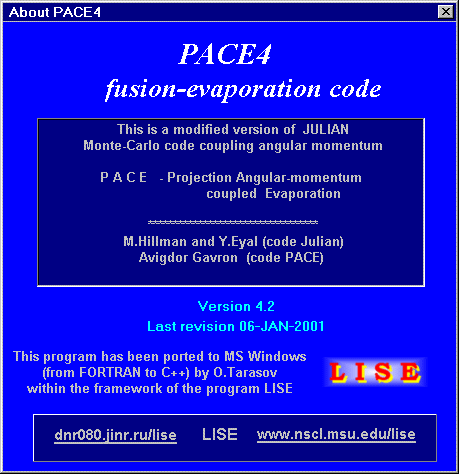
|
|
| lise.nscl.msu.edu
http:"//lise.nscl.msu.edu |
East
Lansing
15-Jan-2002 |

Contents:
1. PACE4: fusion-evaporation code
2.1.1. Configuration file (LCF-extension)2.2. New features
2.1.2. Option file (OPT-extension)
2.1.3. Data file (LIZ-extension)
References
1. PACE4: fusion-evaporation code
1.1 Introduction
The program PACE has been incorporated (after approbation
by the authors) in the LISE package. The expansion of the program LISE
to other reaction mechanisms has motivated the attachment of the program
PACE. The code PACE (developed by A.Gavron [Gav80]) is a modified version
of JULIAN - the Hillman-Eyal evaporation code. PACE (Projection
Angular-momentum Coupled
Evaporation) is a Monte-Carlo code coupling
angular momentum. This code has been ported to MS Windows from FORTRAN
to C++. The FORTRAN (original PACE3) and C (PACE4) source files can be
found at the following ftp-address
ftp://ftp.nscl.msu.edu/lise/PACE_source.
1.2 Modifications
The program PACE has a user-friendly interface in the MS Windows system, where the user can enter information directly in dialogs (see Fig.1), in which the explanation for each parameter is displayed. The entered information is written to files with the extension "in", compatible with the previous versions. The database of recommended values for binding energies [Aud95] was added into the program (see Fig.2). In the new version it possible to calculate up to 10000 cascades at the maximum excitation energy of 2000 MeV the compound nucleus. The calculation results are displayed and formatted in a scrollable window (see Fig.4). The result file is saved in the format "rtf" and can be printed from the program. The user can select (as in the original FORTRAN version) one of five modes (see "INPUT" in Fig.1), but the possibility to input nucleus levels in this version is not available.
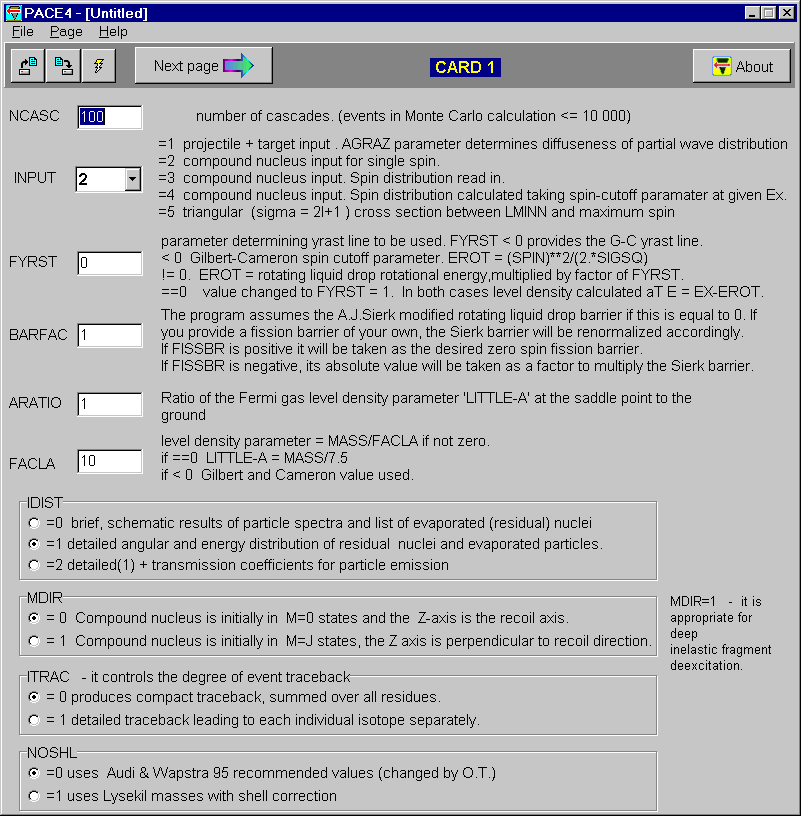
Fig.1. The first input card of the code PACE4.
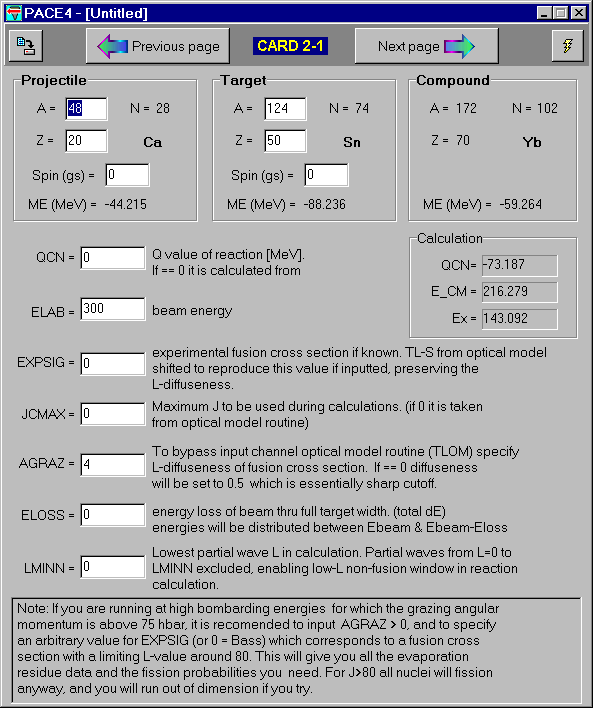
Fig.2.The second card of the PACE4 code for
the projectile and target mode.
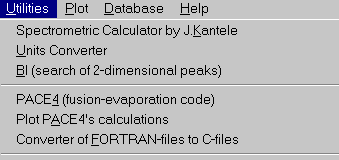
Fig.3. The fragment of the menu "Utilities".
The program can be launched directly from the program
LISE through the "Utilities" menu (see Fig.3). The user can also use the
program PACE4 separately from the LISE package by clicking on the icon
from the LISE folder (Start menu).
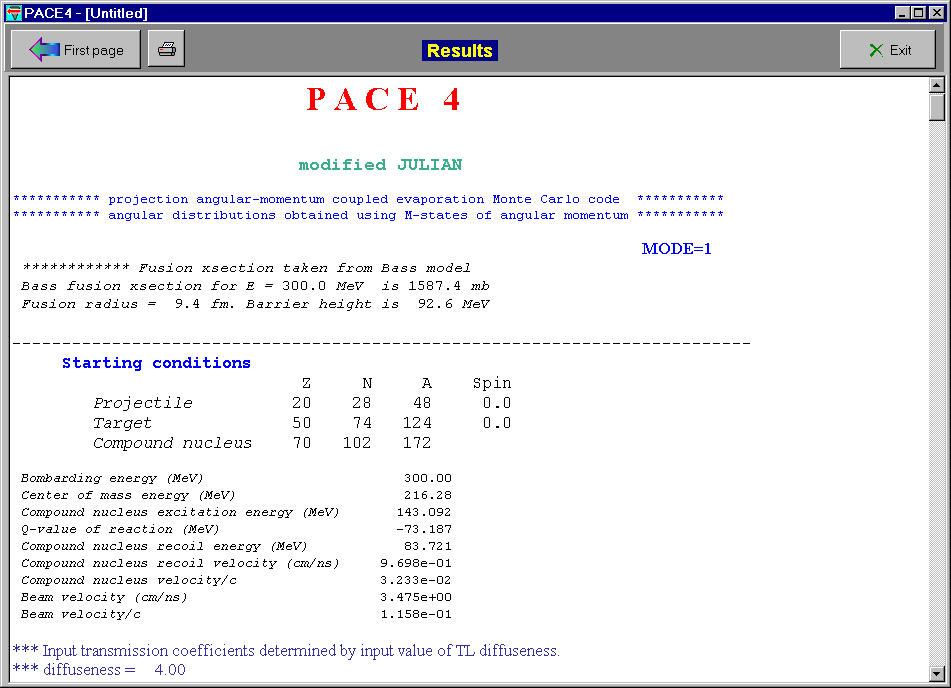
Fig.4. The window of PACE4 calculation results.
1.3 Visualization of PACE4 calculations
The PACE4 calculation results can be plotted within the
framework of the program LISE. For this purpose it is necessary to load
the cross-sections file (extension "cs", default directory is <LISE>/files),
which was created by the program. The plots are obtained of selecting the
menu "Utilities -> Plots PACE4 results" (see Fig.3). Examples of this plot
are shown in Fig.5 and 6.
1.4 Comparisons of PACE4 and LISE AA-model calculations
Comparisons of PACE4 and LISE AA-model calculations for the compound nucleus 215At are presented in Fig.5 (Excitation energy 500 MeV) and Fig.6 (Excitation energy 50 MeV). The upper plots on these figures are the PACE4 calculations, the middle plots the LISE built-in abrasion-ablation (AA) model [Gai91] plotted using the same scales for X, Y, and Z. The lower plots are the same as the middle plots, but using free scales for X, Y, and Z. It is apparent that for high excitation energies there is a large difference between the two models, caused by the large angular momentum, which is ignored by the LISE AA model. The advantages of PACE4 calculations are the possibility to calculate gamma-emission and fission channels, to take into account the angular momentum (important for high excitation energies), whereas the LISE AA-model assumes an angular momentum of zero. However, the LISE AA-model allows to calculate very small cross-sections quickly due to the analytical approach of that calculation, compared to programs using the Monte Carlo method.

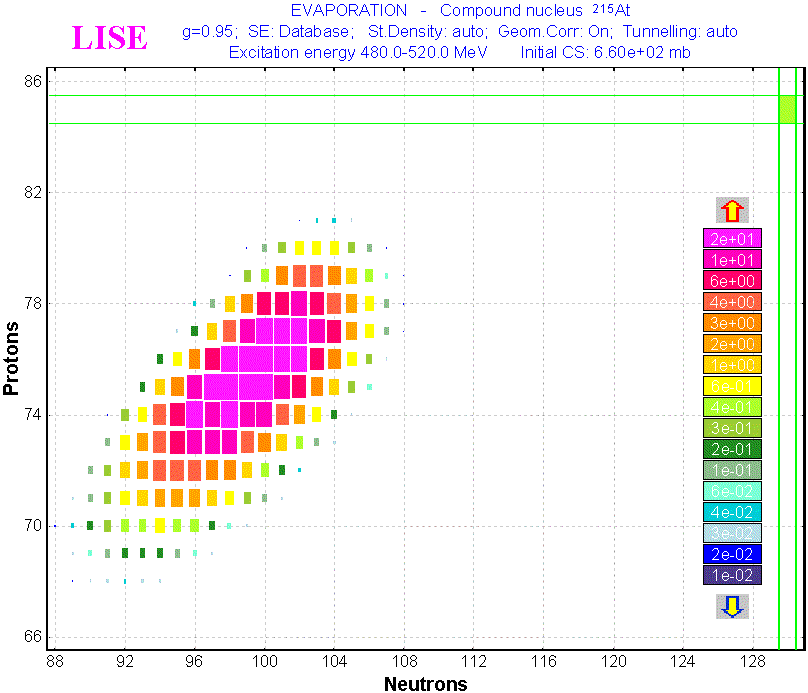

Fig.5. 215Ar
(Ex=500 MeV) evaporation results (see details in the text).
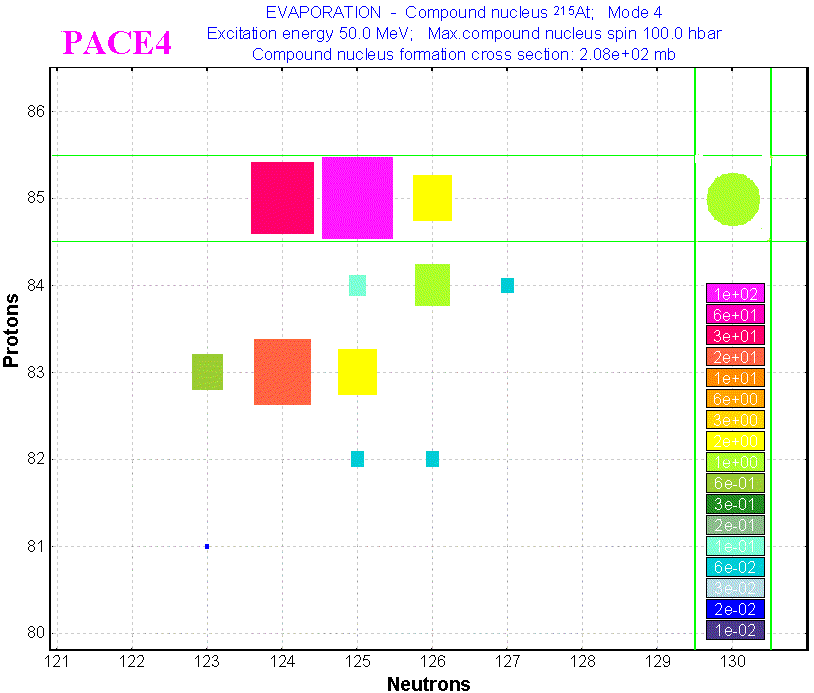

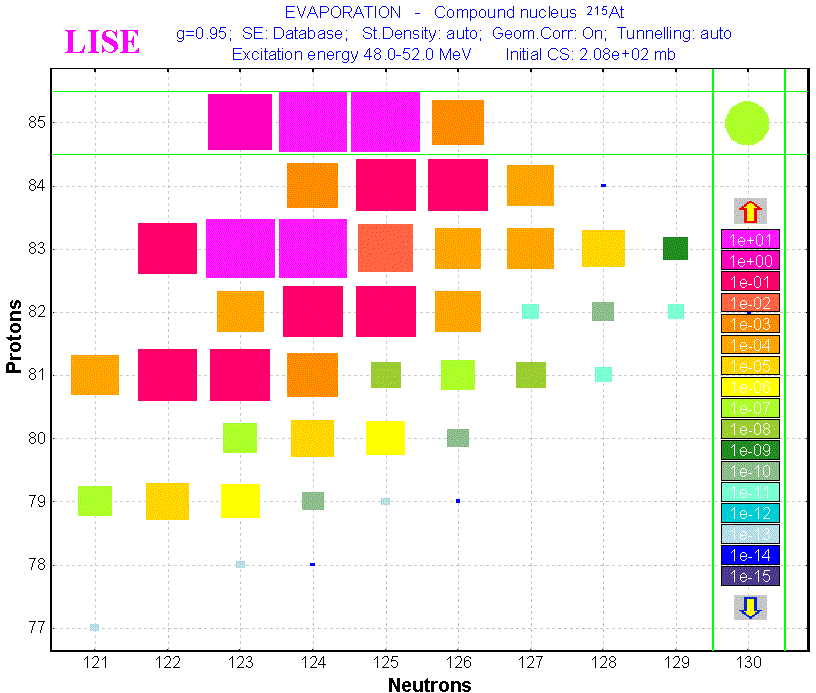
Fig.6. 215Ar (Ex=50 MeV) evaporation results (see details in the text).
2. Option & Configuration files
In order to save and restore the settings (spectrometer characteristics, experiment settings, options of reaction mechanism, entered cross-sections, calculated transmissions and rates) the user uses standard LIZE-files with the extension "liz". However it is very often necessary to apply other set-ups or options of reaction mechanism to some already existing calculations. To do this the code has now the possibility to read an OPTION-file (extension "opt") as well as a CONFIGURATION-file (extension "lcf"). This chapter tries to explain the structure of these files and the new modifications made on the basis of numerous remarks from users.
2.1. Structure of files
2.1.1. Configuration file (LCF-extension)
The fragment-separator characteristics are saved in this
file (subdirectory "config").
There are four sections:
|
|
|
| Object | All slits of spectrometer |
| Acceptances | Momentum and angular acceptances of spectrometer |
| Optics | Beam characteristics, dipole radius, optic matrices of each part of spectrometer, distances |
| Wien_filter | Velocity filter characteristics |
2.1.2. Option file (OPT-extension)
Calculation parameters, visualization options, reaction mechanism options and others are saved in this file (subdirectory "options"). There are 14 sections:
|
|
|
in LIZ-file |
| Distribution | Distributions dimension |
|
| Display | 3d-animation, navigation, sound and etc |
|
| Charge State (Yes/No), Cross Section (Fit/File), Secondary Reactions(Yes/No), threshold=1.0e-10 |
|
|
| Resolution | Energy, Time, and spatial resolutions; Material defect |
|
| Plots | Plot options, Monte Carlo options and etc |
|
| Evaporation | Evaporation options: distribution dimension, modes of decay |
|
| Option: Create reference files (Yes/No) |
|
|
| EvapAuto | Parameters of evaporation auto mode |
|
| Excitation | Excitation energy dialogue settings |
|
| Mechanism | Charge State Method, Energy Loss Method, Energy and Angular straggling methods, Cross Section method |
|
| Velocity | Fragment velocity calculation methods and their parameters |
|
| Momentum | Widths of momentum distribution methods and their parameters |
|
| Friedman | Parameters of Friedman’s momentum distribution |
|
| Convolution | Parameters of Convolution method of momentum distribution |
|
| Internet | Internet options |
|
| MSP144 | Characteristic of MSP144 spectrometer |
|
2.1.3. Data file (LIZ-extension)
The regular LISE-file (extension "liz") consists of the Configuration file (lcf), the sections of the Option file (opt) mentioned in the table (see sec.2.1.2.), the experiment settings and calculation results:
LIZ = LCF + OPT + Experiment settings + Calculation results
The experiment settings include the characteristics of
the beam, target, stripper, wedge, and materials. The names of the configuration
and option files are also saved in the LIZ-file.
2.2. New features
Upon starting, the code reads the LISE.INI file which contains the default configuration and options file names, as well as the list of most recent files. The code loads the default configuration file, and the default options files. If these files are absent the user is informed and the standard LISE settings are used.
The user can set the default configurations in the dialog "Preferences" (see Fig.7). In the new version the possibility to choose a default option file has been added (see the rounded rectangle on Fig.7).

Fig.7. Fragment
of the dialog "Preferences".
The current configuration and options files are displayed in the window "SETUP" (see Fig.8).
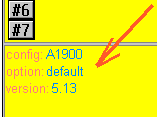
Fig.8. Fragment of window "Setup".
After loading the LIZ-file the code checks the existence of the options and configuration files from their names saved in this LIZ-file. If one of these files is absent the user is warned and the string "????" is displayed in the window "Setup" instead of a file name. Note that it is necessary to set the option "Check LIZ-file consistency" in the "Preferences" dialog.
Important! When the user clicks the button
"MAKE DEFAULT" and then "OK" the current options will be saved in the options
file with the name shown in the window "Setup".
3. File converter from Fortran to C
The necessity to port software from one programming language to another arises quite for programmers. In the field of physics it is connected to the fact that the most popular programming language among physicists was (and still probably is) FORTRAN. As a rule all programs made for computers with multitask systems were started from a command line. However with the fast intrusion of personal computers and CPU speeds superior to that 10-year old VAX- and UNIX-computers it quite often makes sense to port these programs to the most commonly used language nowadays, which is C or PASCAL. To facilitate the work of programmers a file converter from FORTRAN to C was built. This converter is certainly not ideal: the user should still itself edit the C-file, but most labor-consuming operations are taken care of in the converter:
1. Comments;The user’s main work after converting consists in the editing of COMMON-blocks, checking of DO-loops, and functions built by the user. The size of the FORTRAN file should not exceed 64 kB. An example of how the converter works is presented in Fig.9.2. Logical operators And, Or, Equal etc.;
3. Operands "Mod" and "^" changed to corresponding "%" and "pow";4. Operators "Go To" and their corresponding labels;
5. Operators "then", "else", "do", "continue";
6. Junction of lines by the disjointed identifier in 6-th position of line (FORTRAN-case), attachment of the character ";" at the end of line (C-case);
7. Identification of FORTRAN in-built function and replacement on corresponding C-functions;
8. Arrays (replacement of parentheses, splitting of multi-dimensional arrays)
9 Subroutines etc.
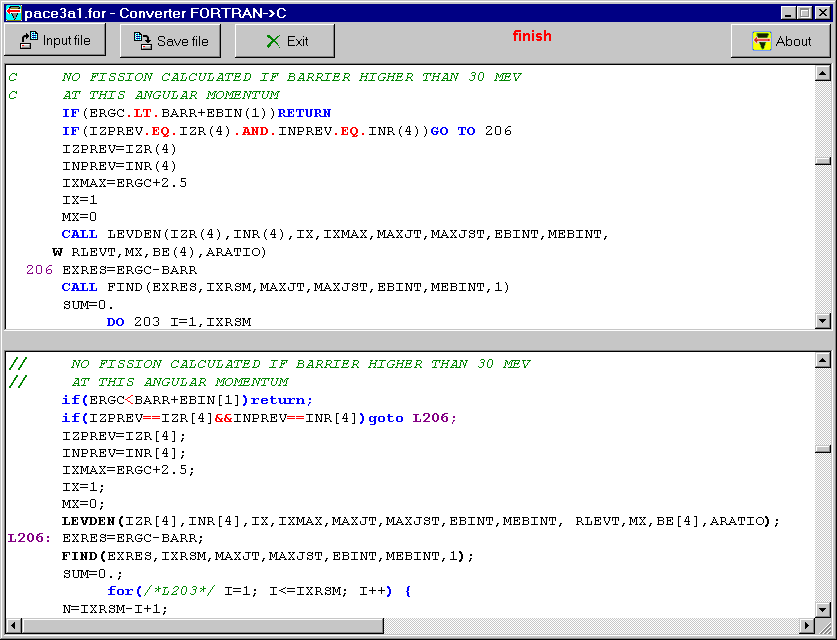
Fig.9. Converter of FORTRAN-files to C.
4.1. Modernization of the Abrasion-Ablation model
The analytical form of parent and daughter distributions has been modified. All distributions have now an exponent base to reproduce the low-energy part better. New modifications allow to input a delta-function as the input excitation energy distribution (see Fig.10). It is recommended to put the evaporation distributions dimension to 64 instead 32 for better quality calculations.
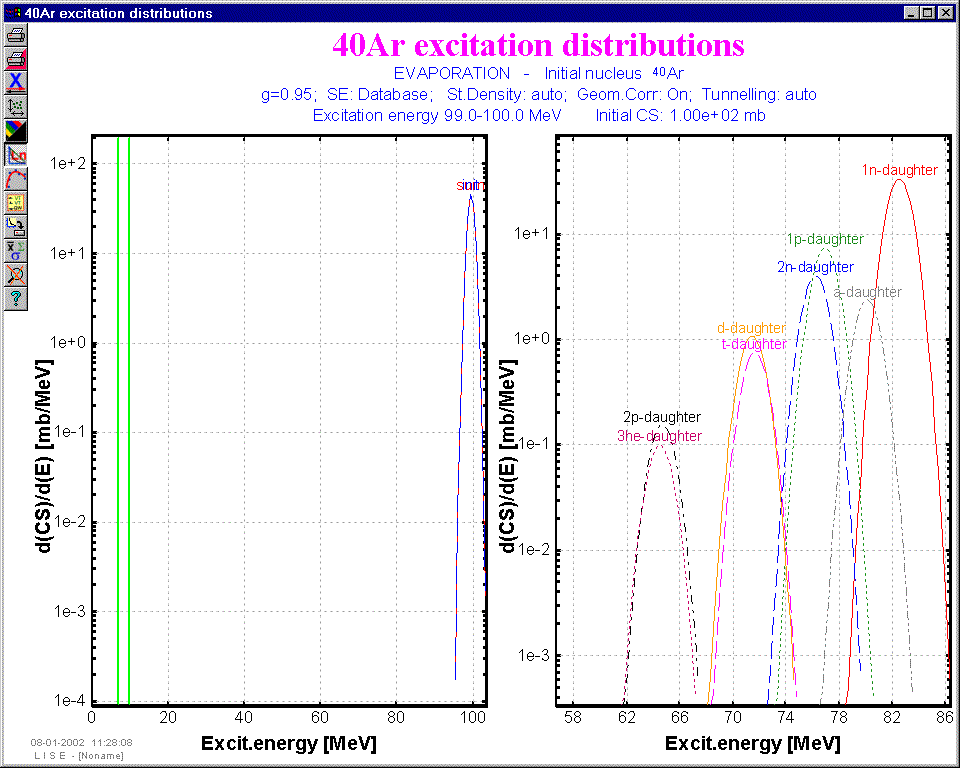
Fig.10. 40Ar
distributions (initial distribution – left plot, daughter distributions
–right plot)
are shown for the case of an 40Ar
initial excitation energy from 99 to 100 MeV.
4.2. New NSCL ftp-address
The NSCL download address has changed! The new address
is ftp://ftp.nscl.msu.edu/lise/.
The LISE site and the LISE’s subroutine to obtain the new version automatically
have been modified.
4.3. New model for projectile fragmentation velocity
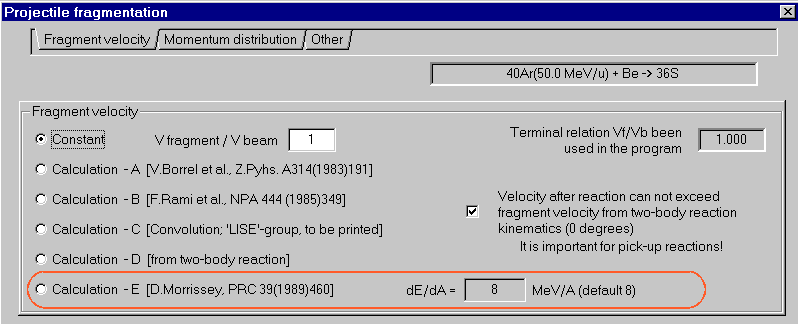
Fig.11. Part of
the "Projectile fragmentation" dialog. The new method to calculate the
fragment velocity is outlined by a red rounded rectangle.
Detailed information of this new method can be found in the reference [Mor89.]
4.4. Changes in the Utilities menu
The code "BI" (from the menu BI),
"Spectroscopic calculator of J.Kantele" and "Units converter" (from the
menu Calculations) have been moved to the menu Utilities
(see Fig.3). Also the new items "PACE4", "Plot PACE4’s calculations" and
"Converter of FORTRAN-files to C" have been incorporated to the menu Utilities
as well.
4.5. LISE code references
The article "The program LISE: a simulation of fragment separators" (D.Bazin, M.Lewitowicz, O.Sorlin, O.Tarasov) has been accepted in NIM A. The reference is NIMA 41218.
A brief version of this article has been published in
the proceedings of the Sixteenth International conference "Cyclotrons and
their applications", 13-17 May 2001, East Lansing, Editor F.Marti, AIP
conference proceedings, Vol.60, p.417.
4.6. Future steps of the LISE code development
References:
[Aud95] THE 1995 ATOMIC MASS EVALUATION, G.Audi and A.H.Wapstra, Atom.Data and Nucl.Data Tables (1995) 1.
[Gai91] J.-J.Gaimard, K.-H.Schmidt, Nucl.Phys. A531 (1991) 709-745.
[Gav80] A.Gavron, Phys.Rev. C21 (1980) 230-236;
(see ftp://ftp.nscl.msu.edu/lise/PACE_source).
[Mor89] D.Morrissey, Phys.Rev. C39 (1989) 486.